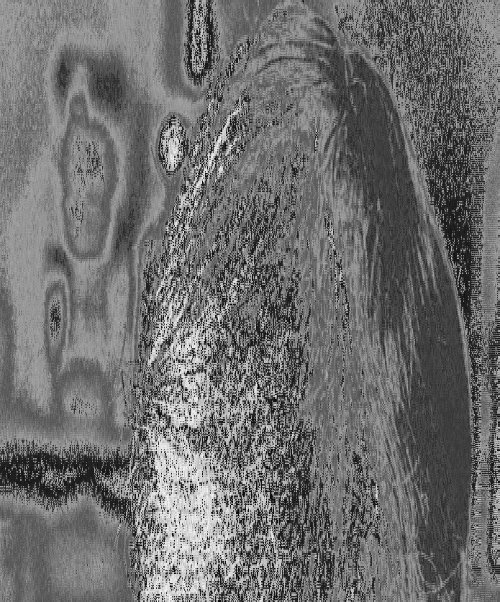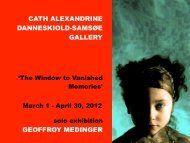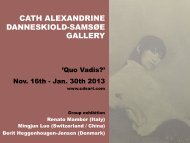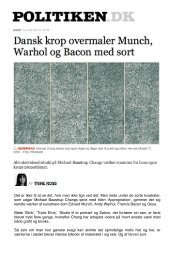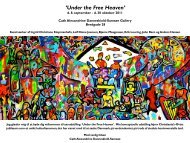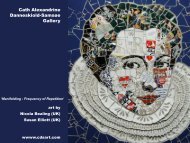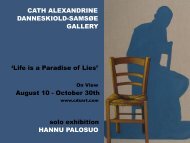Renato Mambor
RENATO MAMBOR - cds art & visibility
RENATO MAMBOR - cds art & visibility
Create successful ePaper yourself
Turn your PDF publications into a flip-book with our unique Google optimized e-Paper software.
The Middle Coursesof <strong>Renato</strong> <strong>Mambor</strong>Gianluca Ranzi<strong>Renato</strong> <strong>Mambor</strong> is one of the most significant voices of theItalian figurative experience and cultural debate of the secondhalf of the XX century; grown up as an artist in Rome in thelate Fifties, when for the first time he experiments a new artisticvision by reducing, through bi-dimensional painting andthen most recent painted wooden silhouettes, the artwork to amental principle and he raises the human being and perceptions,linked to the universe as its detection field, renewingLeonardo da Vinci’s concept, in whose opinion «painting isthe highest mental discourse».The project planned by <strong>Renato</strong> <strong>Mambor</strong> for the Italian CulturalInstitute of Prague blends painting, sculpture and installation,conceived and set up as to favour open and luminous dialoguewith the ancient architecture of the building itself, withits frescoes and decorative sections, by an overall pattern operatingupon the architectural volume which lets the eye casta glance onto the installations and intertwine in new relations.It is springy, ready to take wing, able to pass by the materialconsistency of the artwork through rose openings in the twonew silhouettes of Riguardanti (Glancers-Regarders), whichspreads out in space following the eccentric and centrifugalMandala-lines in the new series of six paintings, crossing andrelating to the live and moving visitors’ eye. <strong>Renato</strong> <strong>Mambor</strong>’sstatement «Know thyself in relation to the multitude surroundingyou» perfectly expresses not only the true spirit of thisexhibition and its very special location, but also the spirit of hiswhole work, that has been leading the artist’s quest for morethan fifty years, tickling such diverse disciplines. The spirit ofthe Globetrotter, as in the title of some works dating back tothe Nineties, relives here in the adventures of the glance setin motion by the mandala-rose windows, which bear the samemeaning, although belonging to different human and culturalgeography. They represent the escape routes and the trajectoriesaccompanying the glance of the Spectator-Regarderthroughout the world, «moving towards the consciousness ofa new lay plea». The glance is free at last, no longer imprisonedin the cage of the optic pyramid of proportional system; itis eccentric and coexistent, tending to the origin without headingfor a single point, because the origin here is in every point,scattered and multi-present.<strong>Mambor</strong>’s works, as we can appreciate in this last project,have never been a mere synthesis of different languages, buthave strived to mirror the totality, difficult and problematic, oflanguage and other-from-language, of construction and thelife knitting it. Overcoming the boundaries of architecture bysewing space playing with reference and mirroring upon thecomplexity of the world, from Glancers-Regarders towardsOmbre Immutabili (Immutable Shadows), up to Raccoglitori diPioggia (Rain Collectors), thus shows the will to reflect overwhat transgresses logos and over incoming and outgoing experiences,recognizing that sense of sacredness starting overfrom the peculiar location of the Prague exhibition. The resultis once more the working up of a path, a new experienceand spiritual adventure connecting faraway worlds, dischargingfake certainties, and opening up ways into the apparentlysmooth and continuous surface of reality.<strong>Mambor</strong> breaks the frame, he has been doing it for fifty years,a limit which, as Simmel reminds us, separates art from life,guaranteeing abstract and separate integrity of the artwork.In these moments of breaking and illumination suggested by<strong>Mambor</strong> the sacred takes place, its accent on the coexistenceof differences and on cultural interaction, on inevitable «stranger’sestrangement» thought up by Derrida. Sacred art, publicart, giving this term the amplest meaning, including sharingand participation, following a vision dating back to theatricalexperiences of the Trousse group: this means recreating underdifferent aspects that creative laboratory of empathy andhospitality, awakening ethical tension helping us to live life asa form of antagonism against exclusion and separation.Curiously enough, the exhibition path triggers eccentric andmulti-directional circularity, by relating works, space and visitors:there sounds once more the dynamics of the Osservatore(Observer), conceived by <strong>Mambor</strong> from the Nineties on,10 11


